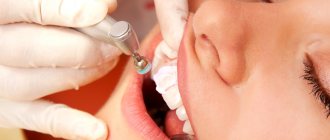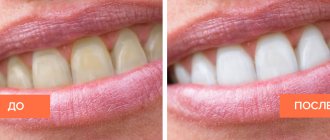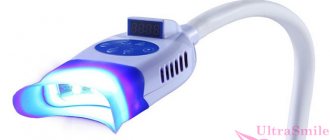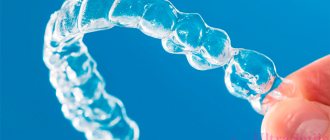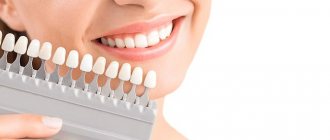From this article you will learn:
- types of professional and home whitening,
- which method is better and safer,
- teeth whitening in St. Petersburg and Moscow – prices 2022.
The article was written by a dentist with more than 19 years of experience.
Cosmetic teeth whitening can be professional, in which case it is performed in a dental clinic, or at home, using at-home products (for example, Crest whitening strips, Opalescense whitening gel, and special toothpastes).
As a dentist, I have to admit that home remedies for teeth whitening are becoming more effective every year. Already today, some of them allow you to achieve results that are quite comparable to the effectiveness of professional teeth whitening techniques - such as “Zoom”, “Beyond Polus”, “Opalescence Boost”, etc.
There is a lot of misinformation being circulated regarding professional and home whitening. For example, you will never be able to lighten your teeth by 8-12 shades - which is what they constantly say in advertising. The real result is 4-6 tones on the VITA scale (Fig. 2). And besides, whitening is not as safe for the hard tissues of teeth as they try to make it out to be.
In this article we will talk about the pros and cons of all the main methods of home and professional whitening, compare their cost and effectiveness. Below you can read reviews on teeth whitening, as well as see “before and after” photos of various whitening techniques.
Description of the method
Laser whitening allows you to keep your teeth white and healthy for a long time. During the procedure, the doctor applies a gel to the surface of the teeth, which is then activated using a laser. The laser acts so that the gel breaks down into active particles. A chemical reaction occurs: active oxygen is released. Its atoms penetrate deeply into tooth enamel and dentin, removing pigments accumulated there. Pigments accumulate in the cracks of the enamel and give it a yellow tint. The depth of their penetration does not allow them to be removed at home. The laser promotes the rapid penetration of oxygen atoms into the dental tissue.
Thus, laser whitening uses two main components - a special gel based on hydrogen peroxide (contains active oxygen) and laser radiation (a process catalyst).
The duration of the procedure is approximately 30-45 minutes. In one session, tooth enamel brightens by 7-10 tones. The safety of laser whitening has been clinically proven and verified through various medical studies.
In some cases, the effect can be lightening by 4-5 tones, depending on the initial condition of the teeth. Sometimes a repeat session is required after a certain period of time (it is determined by the attending physician).
In-office teeth whitening
To whiten teeth, the doctor treats the surface of the teeth with a gel substance, and then uses a special activator that catalyzes the chemical processes necessary to lighten the enamel coating. The following can be used as such an activator:
- Thermal impact.
- Action by ultraviolet radiation.
- Laser.
The use of activators helps reduce the time that aggressive substances remain on the patient’s dental surfaces and at the same time enhances the whitening effect. The main advantage of professional techniques is the achievement of a significant and noticeable positive effect in changing the color of the enamel: it brightens by 5-7 tones in just one visit to the dentist’s office.
However, it is worth knowing that chemical teeth whitening, while highly effective, also has a significant disadvantage - it negatively affects the condition of the enamel layer and, with frequent use, can cause the process of its thinning, which is fraught with the risk of developing caries. Therefore, after chemical teeth whitening, experts recommend undergoing additional remineralization and fluoridation procedures, which will help strengthen the enamel and maintain its integrity.
Main indications
The appearance of teeth is affected not only by external reasons (smoking, caries, coffee), but also by internal ones (age-related changes, tooth wear, cracks, pigmentation). Modern technologies make it possible to quickly and painlessly eliminate age-related darkening of enamel, remove plaque that occurs due to the consumption of coloring foods and drinks, and lighten teeth darkened due to smoking.
Long-term whitening is especially important for people whose work involves constant contact with other people when they need to show off their smile. An attractive appearance not only gives you self-confidence, but also increases the loyalty of potential customers.
The effect of the procedure lasts for 2-3 years, depending on the individual characteristics of each patient.
In-canal teeth whitening technology
This technique is used exclusively for “dead”, pulpless teeth, the enamel of which may darken due to the action of substances released when the pulp dies and the penetration of coloring pigments into the deep layers of the natural enamel coating. Professionals call the procedure endobleaching. How it is carried out and what its effectiveness is – we will look into it in detail.
Types of laser whitening
The procedure is carried out in two main ways (depending on the equipment of the dental clinic and the recommendations of the dental hygienist):
- using a diode laser (photochemical whitening), has blue light radiation, a more budget option;
- using KTP (neodymium laser), has green radiation and an anatomically shaped attachment, a more expensive and effective option.
As a result of gentle exposure, demineralization of teeth does not occur. The average period for keeping teeth white is 5 years (depending on individual characteristics and the type of bleaching, it can vary up or down).
Teeth whitening using a KTP laser allows for true photo-whitening. It provides brighter teeth shades. This allows you to remove stubborn, intense deposits that are resistant to other methods of exposure.
How does the procedure work?
Dentists recommend the following preparatory measures before laser whitening:
- cleaning teeth from plaque using ultrasonic and Air-Flow methods
- treatment of gums in the presence of diseases;
- polishing teeth with a special paste containing abrasive particles;
- patient instruction.
Laser teeth whitening is a professional technology, so it is carried out only in an equipped clinic. The procedure itself consists of several stages:
- examination of the oral cavity by a specialist, detection of problems that require immediate solutions, exclusion of possible contraindications;
- preparation of the working cavity and isolation of surrounding tissues (for this, protective glasses for the eyes, lip holders, liquid photopolymer for the gums or a special latex scarf - rubber dam are used);
- preparing a whitening gel and applying it to the teeth (it is painted in a bright color, which allows the doctor to see the distribution of the composition over the surface of the teeth);
- activation of the gel using laser radiation (one session lasts 10-12 seconds, each tooth is illuminated by a laser, without overheating the surface of the teeth and pulp);
- using pressurized water to thoroughly remove the gel (using a saliva ejector);
- removal of insulating means and holders;
- fluoridation of the surface of teeth.
At the last stage, fluoride varnish is applied to the hard tissue of the teeth: this is a painless completion of the procedure. It gives teeth a natural shine and a healthy appearance. The gel, after penetrating into the dental tissue, remains active for several more days, cleaning their surface from remaining pigments and healing the teeth.
Home methods for teeth whitening using specialized chemistry
Home teeth whitening methods differ from professional methods in that they use formulations with a reduced concentration of a bleaching agent - usually its content in pastes and gels for home use does not exceed 10-15%, while in professional products it is much higher - up to 35%. .
This concentration was not chosen for home whitening products by chance: when using gels and pastes independently, a person cannot properly protect the mucous membranes of the mouth and gums from the negative effects of aggressive substances, which can lead to burns.
Also, the difference between professional and home methods will be in the following nuances:
1. When using home methods, a pronounced positive result will not come so quickly: usually, to noticeably lighten the enamel, you need to use gels, pastes and aligners for at least 14-15 days. Professional chemical whitening will give the desired result in just one visit to a specialist.
2. Professional whitening uses both activators that speed up the process and substances that protect the enamel, therefore, in comparison with home technologies, it is both more effective and safer.
Home whitening products can be used either independently or under the supervision of a dentist. The second option will be the optimal solution in terms of not only efficiency, but also safety, since specialists will make individual mouth guards for the procedure and carry out a competent selection of the whitening composition.
The mechanism of action of home whitening in this case is that special acidic substances from the composition initially make the enamel coating more porous and permeable, and hydrogen peroxide eliminates darkening and plaque. Wearing individual aligners while using the whitening gel will help avoid burning sensitive tissues. If we talk about the advantages of home whitening, we can note the fact that if it is damaged, the negative effect on the enamel is to a lesser extent, but it also takes longer.
Laser whitening: benefits
This whitening technology is currently the market leader in dental services. This is due to the important advantages of laser whitening :
- the technique preserves the chemical composition of tooth enamel;
- the procedure is performed quickly and painlessly;
- tooth sensitivity does not increase;
- no anesthesia required;
- the tooth surface becomes lighter;
- perfectly brightens the tooth enamel of smokers;
- laser radiation has a bactericidal effect;
- long-term preservation of aesthetic effect.
The concentration of the active gel is selected individually, the doctor controls the duration of the procedure, so the effect is safe and does not cause discomfort. Laser whitening, the price of which is justified by the results, is a leader among other methods.
Laser technologies save the patient’s time; the most resistant pigments can be dealt with in 30-40 minutes.
Ultrasonic teeth whitening
Ultrasonic whitening is practiced in dentistry quite often and the demand for the technology is explained by the fact that it not only effectively removes plaque, but also destroys tartar. Teeth whitening with ultrasound is considered gentle and harmless to the state of the natural enamel coating: ultrasound acts exclusively on deposits and does not damage the enamel layer or cause negative changes in it, which are inevitable with chemical methods.
However, despite the safety of the method, after ultrasonic whitening, unwanted side effects may appear, in particular, increased tooth sensitivity. Proper preparation for the procedure, as well as its competent implementation, will help to avoid such consequences. An experienced dentist who conscientiously performs his work will never carry out ultrasonic whitening for periodontal inflammation or untreated caries.
If the patient has these diseases, the dentist will definitely treat them before teeth whitening. Also, before using ultrasound, procedures to saturate the enamel and dentin with minerals and macroelements will not be superfluous. They will help protect the natural enamel coating, strengthen it, and also prevent tooth hypersensitivity to external irritants.
The use of ultrasound is an excellent opportunity to return teeth to their natural color, as well as to carry out high-quality oral hygiene. Ultrasound will remove tartar even in the most inaccessible areas, and in addition, it also removes “smoker’s” plaque, against which all other methods are practically powerless.
Deposits on dental surfaces are destroyed due to the action of ultrasonic waves created by special devices or scalers. Even hard old formations collapse and are easily separated from dental surfaces, while ultrasound does not have any harmful effect on natural enamel.
To make the procedure faster and more effective, it uses not only ultrasound, but also water. Water flows under pressure through the end of the device and protects tooth surfaces from overheating, and also improves the process of separating deposits from the enamel. It is important to know that overheating of teeth is an extremely negative process that can subsequently lead to inflammatory processes in the pulp, and inflammation of the pulp involves a complex treatment process, and sometimes depulpation of the tooth.
The ultrasonic whitening process is completed by polishing the dental surfaces. The procedure usually takes place without any discomfort for the patient, but if your teeth are hypersensitive or there is mild inflammation of the gum tissue, it would be advisable to use a mild anesthetic. Usually a gentle agent based on lidocaine is chosen.
Good to know: Ultrasonic teeth whitening is quite possible to do yourself - all you need to do is purchase a special ultrasonic brush and use it regularly. However, keep in mind that the in-office procedure is better, better and safer in terms of efficiency, since it uses professional equipment and is carried out by a specialist.
The ultrasonic waves that the brush emits are inferior in power to the radiation of professional devices, but at the same time they are quite capable of coping with plaque. It is worth knowing that not everyone can use such brushes. They cannot be used by pregnant and lactating women, people with installed cardiac devices, crowns, veneers, or braces. You will have to stop brushing your teeth with an original brush even if you have many fillings installed - waves can destroy them. The price of ultrasonic teeth cleaning at VENSTOM dentistry is 2,200 rubles (the entire jaw). Air-Flow Technology
When using Air Flow technology, the effect is achieved due to the active action of a powerful air-water flow on the outer sides of the teeth, which also contains an abrasive substance. Traditionally, ordinary baking soda is used as an abrasive in the procedure. There is no need to worry that soda will damage tooth enamel; its particles in the solution are too small.
The components are mixed into the solution almost before it is supplied to the dental units and at the very tip of the working unit. The unit itself is firmly fixed on a special dental unit and then the patient’s teeth are treated with a mixture of water, air and soda. The power of the flow is such that dental surfaces are cleaned in a matter of seconds.
The advantages of Air-Flow whitening technology include not only the speed of the cleaning process, but also its high quality. The jet supplied from the unit easily penetrates into the most difficult to reach areas - interdental spaces, removes deposits above the gums and even cleans teeth under orthodontic structures. The duration of Air Flow whitening is only 30-40 minutes and during this time you can lighten tooth enamel to its natural shade.
The only drawback of the technology is that it is ineffective against tartar. If solid deposits are present in the patient in significant quantities, it is recommended to use ultrasonic cleaning. It is also worth considering the fact that if Air Flow whitening is carried out in violation of the technology, hypersensitivity of the teeth may occur, which may be accompanied by painful and unpleasant sensations. For this reason, you should seek services from professional, modern dentistry with an impeccable reputation among patients.
The Air Flow technique has a number of contraindications, including respiratory diseases, pregnancy, untreated caries, and periodontitis. Indications for teeth whitening using this method include not only changes in the color of the enamel and the presence of tartar: the procedure is often prescribed before the placement of orthodontic and orthopedic structures, or surgical manipulations. After brushing with Air Flow, tooth enamel becomes perfectly smooth and even. The service of teeth cleaning using Air Flow technology is offered to our patients by our dentistry in Moscow - VENSTOM. Cost of the service: 2,640 rubles (entire oral cavity).
Contraindications
Laser whitening has no disadvantages, but depending on the patient’s health condition, some limitations may be identified for its implementation:
- age under 16 years (the doctor looks at the formation of the bite and the hardness of the enamel);
- period of pregnancy and breastfeeding;
- increased tooth sensitivity or damaged enamel;
- carious processes;
- leaky restorations;
- diabetes mellitus and endocrine diseases.
There are quite a few disadvantages and contraindications, so many patients prefer laser teeth whitening in Moscow in a well-equipped clinic with a professional doctor.
Dental care after the procedure
The final color will appear only after a week, so immediately after the procedure it is important to consolidate the result. For several days after the procedure, it is recommended to follow a “white” diet, that is, exclude from the diet all foods with coloring pigments. These include: red wine, strong tea, coffee, fruits, berries, food with food coloring.
During the week, it is better not to smoke or consume alcoholic beverages, coloring foods and drinks. Take care of your tooth enamel regularly. To brush your teeth (twice a day), choose a suitable brush and toothpaste. The attending physician will give recommendations.
The cost of the procedure is fully paid for by the therapeutic and aesthetic effect, safety, and long-term preservation of the whiteness of the enamel. It is necessary to choose a clinic wisely and carefully after reading reviews . Pay attention to the experience and qualifications of the doctor. Our clinic offers the most innovative technologies for maintaining dental health.
Mechanical teeth whitening techniques
When using mechanical methods, the enamel coating brightens due to high-quality cleaning of dental surfaces from hard and dense formations. The result will be especially noticeable with dark plaque from smoking, constant consumption of coffee and strong tea. Removing plaque and tartar in such cases radically transforms the appearance of your smile. For mechanical procedures, ultrasonic cleaning and Air-Flow technology can be used. We will discuss the features of each method in detail below.
Calculate the cost of treatment by taking a short test in 20 seconds!
Do not delay your treatment, because in this matter time plays against us.

